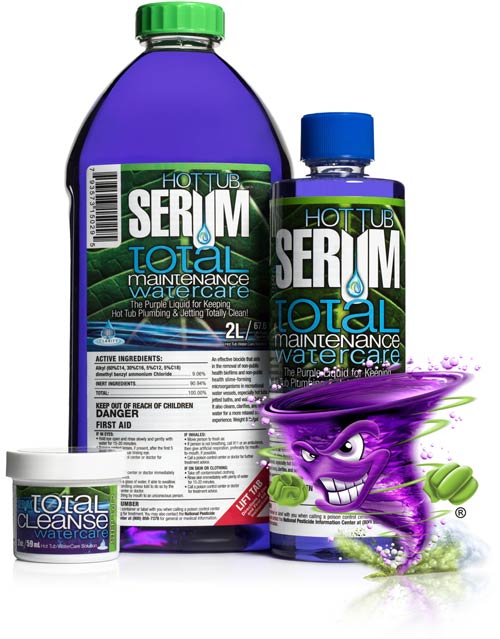You bought your spa for the enjoyment, relaxation, comfort, massage, and likely also for a bit of social interaction with your family & friends. All of these are based on clear, clean, pristine water in your hot tub. In a nutshell, that is our mission at Serum Watercare – Pure, Pristine Spa Water!
Serum products can prevent and/or resolve many spa water issues. Not all, but many of them. However, as with all problems, a good understanding of the issue helps ensure the best solution. Hence, we have created our Serum Problem Solver1.
What issues are you having with your hot tub?
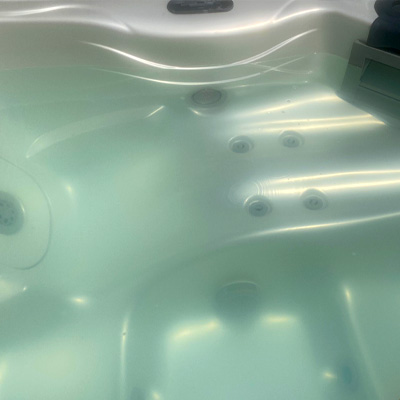
Cloudy Water
Cloudy Water
- What causes cloudy water in your spa?
As a former spa dealer who started out selling, delivering, and servicing hot tubs, I know that 99% of the time, cloudy water has one cause – insufficient and/or ineffective sanitizer.
Regarding ineffective sanitizer, if you are using chlorine (and that includes dichlor, most salt systems, and most mineral systems) your chlorine may be ineffective as its ability to kill and remove bacteria and other pathogens is dependent on the pH of your spa water. If your spa water pH is above 7.8, the chlorine is doing almost nothing to sanitize your spa water.
- 1st Step
Ensure your pH is in the proper range of 7.2 – 7.6. Add pH Down if too high and pH Up if too low. Note also that when you are adjusting pH, it takes your spa water 4 – 5 hours to completely adjust. Hence, once you add some pH Down or pH Up, do not test for pH again for 5 hours. If you don’t wait you are likely to blow right through the proper range and discover your pH is again out of whack on the other side of the scale the next day.
- 2nd Step
Check your sanitizer level. Chlorine should be in the 2 – 4 ppm range and Bromine in the 3 – 5 ppm range. Once you have your pH and sanitizer in the proper range, add Serum Total Maintenance at the rate of 1 oz. per 100 gallons per week.
Let me note that Total Maintenance assists in keeping your spa water clear in 2 ways. It is both a highly effective secondary sanitizer and a very effective pH buffer. Total Maintenance takes some of the sanitizing load off your primary sanitizer and, by keeping your spa water pH in the proper range, it ensures that chlorine can do its job.
- 3rd Step
This is important, do not add Total Maintenance to your spa water until you have your pH in the proper range. As a strong pH buffer, if your pH is say 8.2, it will lock that in, making it very hard to correct your pH if you add Total Maintenance before correcting your pH.
- What to Expect
It will take 1 – 4 days for your spa water to clear up, but it will.
- What else?
There are a number of Spa Clarifiers available to use in a spa. Generally, they work however the problem with them is they only address the symptom, not the underlying problem. Since the underlying problem is spa water that is not properly sanitized, using spa clarifiers is problematic at best.
Please also refer to our Blog “Let’s Talk About Cloudy Water”.
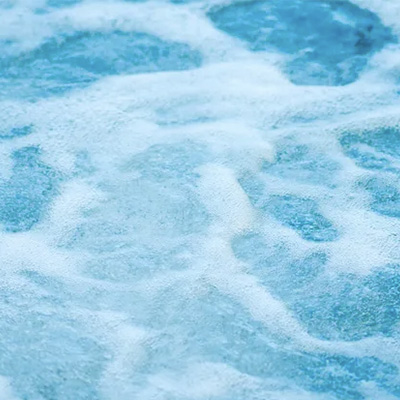
Foam on your water
Foam on your water
- What causes foam in your spa?
When you are operating your hot tub, particularly with the “air” on, a small amount of foam on the surface of the water is normal. However, it should dissipate within 5 – 10 seconds after your stop your jets. If the foam does not dissipate this quickly, and particularly if it continues to build as you use your hot tub, you definitely have a water quality issue(s).
- 1st Step
When you shop your spa showroom or online, you will quickly find various “Foam Down” products. They work – sort of. They will eliminate the foam almost immediately however this will last for about 20 minutes before you have to add another squirt to your spa water. Worse, they are not resolving the fundamental problem with your spa water. They are just masking the problem.
- 2nd Step
Potential issues causing excessive foam basically break down into two categories – those issues related to normal use and foreign chemicals in our spa.
Foam may begin to appear as the time since your last drain and fill lengthens. Chemicals you have added to your spa water, to keep it free of pathogens and adjust your pH, begin to build up in your spa water. Generically this is referred to as TDS (Total Dissolved Solids). In this case, foam is simply an indication that its time to drain your spa and refill with fresh water.
- 3rd Step
However, foam can also indicate other problems.
Foam may indicate the presence of phosphates in your spa water. If you have a significant level of phosphates (above 200 ppb, note this is billion, not million) you might also be noticing difficulty maintaining a proper sanitizer level. Phosphate removers are readily available, though you will find they are packaged for pools.
Foaming may also be the result of detergents and/or soaps in your water. The best way to prevent his is to wear the same clothes while using your spa and simply hanging them to dry (don’t wash them). Drain & refill your spa if this is the problem.
If you have been using suntan lotions before using your spa, these may be the source of foaming. Again, you will have to drain & refill your spa. Best practice here is to shower before using your spa.
- Two more things
- The Calcium level in your spa water will have a big impact on foaming in your spa. Your spa water should have a Calcium level (also called “hardness”) in the 150 – 250 ppm range. If your Calcium level is below this, any issues in your spa water are highly likely to result in foam. Use our HTS Calcium Plus to increase calcium in your spa. If your Calcium level is in the proper range, you may still see foaming but not so quickly as with lower levels of Calcium. Finally, if your spa water Calcium level is very high (above 400 ppm) you may never see foaming no matter how messed up your spa water.Note that Hot Spring and Caldera Freshwater Salt Systems want you to have a very low level of Calcium, in the 25 – 75 ppm range. One of their Start Up items is their “Vanishing Act Calcium Remover”. With this low level of Calcium, foam is more likely to be seen in these spas, however its just an earlier indication of spa water issues that should be resolved.
- Please also refer to our Blog “Foam on your spa water”.
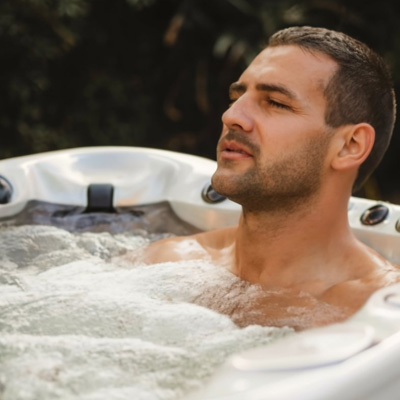
Musty Odors
Musty Odors
- What causes spa odors?
Very few people know the true cause of those musty odors you sometimes notice when opening a spa – particularly if you have not used your spa for a while. These odors come from bacteria growing and multiplying on the spa shell ABOVE the water line.
Here’s what’s going on. When you (and others) enter a spa, you displace water causing the water level to rise. When you later leave, the water level recedes leaving a band of water around your spa, approximately 2 – 5” high above the water line. I call this the “tidal zone”. The water in this tidal zone contains bacteria and it’s no longer in contact with spa water, hence no sanitizer is available to kill them. You close your spa cover, leaving a warm, moist environment – just what bacteria love. They start multiplying, generating this musty odor.
Note that most people think these odors come from the cover, and to a limited degree they might. But as your spa cover does not usually come in contact with the spa water, your spa cover is generally not the source of these smells.
- Stopping Spa Odors
Preventing these musty spa odors is easy – Use our Serum Triple Action Spray. Spray this tidal zone just before you close your spa cover. By the way, to our knowledge, there is no other product available to solve this problem. It’s unique to Hot Tub Serum.
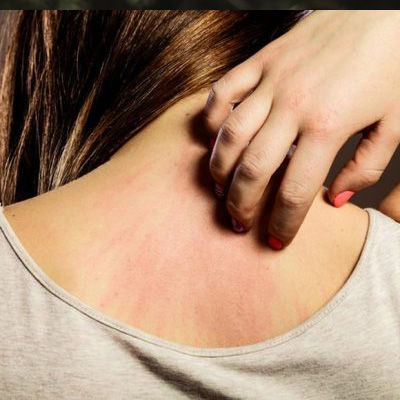
Hot Tub Rash (Folliculitis)
Hot Tub Rash (Folliculitis)
- What causes Folliculitis?
Generally speaking, hot tub rash, or Folliculitis, is due to improper sanitizing of your spa water. The cause of the rash is a bacterium, Pseudomonas aeruginosa, that gets in your skin pores causing inflammation (or a rash). Pseudomonas aeruginosa is actually rather common and found in water, soil, etc. However, if it’s allowed to concentrate in spa water due to insufficient sanitizer, you can wind up with hot tub rash.
- 1st Step
I’ve noticed over the years that folks seems to have different levels of sensitivity to Pseudomonas. I’ve had many instances where a spouse reports hot tub rash, yet the other spouse, using the same hot tub for the same period of time, reports no issue. If you want harmony in your spa, keep your spa water pristine.
- 2nd Step
There is a simple two-step solution. First, check your water weekly to ensure you have the proper level of sanitizer in your water. The most common sanitizer is dichlor. We have HTS Dichlor available in both 2lb. and 5lb. containers. Second, also weekly, add Serum Total Maintenance to your spa water. Total Maintenance keeps your pH in the proper range, thereby ensuring your sanitizer is effective, AND it is also a secondary sanitizer to ensure your spa water is pristine, even when the primary sanitizer fails.
- 3rd Step
Less commonly skin rashes can be caused by chemical sensitivity or low pH in your spa water.
Some folks are just sensitive to chlorine, though I find very few are sensitive to bromine. If you find that chlorine bothers your skin, you might switch to bromine by using our HTS Bromine Tab. If even bromine causes you issues, then we suggest using a biguanide sanitation method. Alternatively, you might consider a salt-system spa. Most do generate chlorine but because there are no other chemicals in the water, and salt is beneficial for your skin, you might find a salt-system solves the problem for you.
Very unlikely, but low pH might also cause a skin rash. Why is this unlikely? Because you test your water regularly (I’ll suggest at least once a week) and if you are using Serum Total Maintenance you are unlikely to see much of a change in pH even over many weeks.
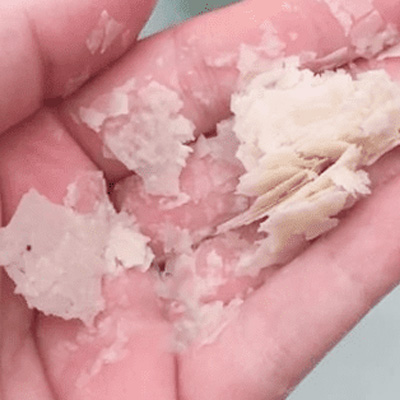
Deposits on your spa shell
Deposits on your spa shell
- What causes spa shell deposits?
Most commonly, deposits on your spa shell are due to calcium scaling. In mild forms this appears as a sort of “dust” on your spa shell. As it gets more severe, this scaling becomes very hard and will feel like sandpaper.
Realize that this scaling is not just on your spa shell. It will be everywhere under water in your spa, including inside your jets (hence they stop spinning), in your filter(s) & plumbing (restricting water flow), and in your pump. This scaling is more than an annoyance. It can cause serious problems in your hot tub.
Calcium scaling is ALWAYS due to high spa water pH. If your pH is above 8.0, your spa is at risk of Calcium scaling. It’s true spa water with higher levels of Calcium, particularly when above 250 ppm, is more likely to experience Calcium scaling however, it still will not occur if your pH is in the proper range of 7.2 – 7.6.
- 1st Step
Let me note that you want a certain level of calcium in your spa water for two reasons.
- Water “likes” to have other minerals dissolved in it hence, soft water is actually mildly corrosive. Over a long time, soft water will cause pitting in the metal components in your spa – obviously not something you want to see.
- Calcium in your water also helps to reduce foaming, so much so that spas with high levels of calcium (above 500 ppm) will rarely see foaming while spas with low calcium levels (under 50 ppm) will often see foaming.
Bottom line – You want around 150 – 250 ppm of calcium in your spa water. If your tap water is naturally “soft” (low in calcium), our Calcium Plus allows you to easily add calcium to your spa.
- 2nd Step
There is a very easy, simple, and inexpensive cure for calcium scaling – vinegar. Vinegar is acetic acid. It will dissolve the calcium. Importantly it will remove the calcium everywhere scaling occurs, including your spa shell, the jets, and inside your spa’s plumbing.
You can use a more concentrated vinegar (20 – 30% acetic acid) available at gardening stores and some home improvement stores however this in considerably more expensive than the plain-old vinegar available at your grocery store. Depending on the gallon capacity of your spa, you will likely need 3 gallons of store-bought vinegar. Simply throw the 3 gallons of vinegar in your spa. Don’t use your spa!
- What to Expect
Unless you have a really heavy load of calcium scaling, after 24 hours you likely will find the calcium scaling completely gone. It’s been dissolved back into your spa water.
However, your spa water pH is likely too low as vinegar is an acid. If the pH is only a bit lower than the desired 7.2 – 7.6 pH, you can simply adjust it. If it’s quite low, you are likely better off draining and refilling your spa. In either case, remember how you got the calcium scaling. You let the pH get too high – above 8.0.
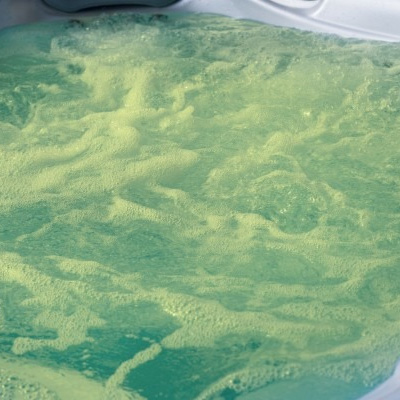
Colored water
Colored water
- What causes odd colors in your spa water?
Though odd colors in pool water are often caused by various types of algae, this is highly unlikely in a hot tub. Odd colors in spa water are usually the result of either pH that is quite low or high bromine levels, or both. Less commonly, if you have high levels of metals in your spa water, you may also see some odd colors.
- 1st Step
Make sure your spa water pH is in the 7.2 – 7.6 range. If you are using bromine as a primary sanitizer, ensure this is in the 3 – 5 ppm range.
Note: Usually high bromine levels, though bad for you and your hot tub, will not cause colors in your spa water all by itself. However, if you add a non-chlorine based shock (MPS) to your water and you then see a yellow – brownish tinge to your spa water, you likely have high bromine levels. Often this coloration will go away within an hour, but you still need to get your bromine level back in the 3 – 5 ppm range,
- 2nd Step
If both of the first two potential causes of odd colors are ruled out, you next need to check for metals in your spa water. Your local spa dealer likely has a test for metals. If you have metals in your water, the solution is a metal sequestering agent, also likely available from your spa dealer. These sequestering agents don’t actually remove the metals. They render them chemically inert so that they do not cause problems maintaining your spa water.
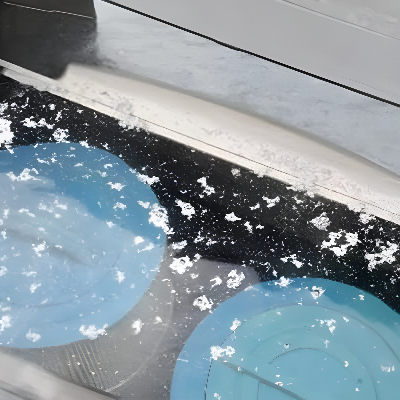
Flakes in your water
Flakes in your water
- What cause flakes in your spa water?
There are basically three reasons you might see flakes in your spa water. The first, and most likely, is calcium scaling. Generally, this won’t appear as flakes floating in your water, but it can.
The second is biofilm. Again, this doesn’t usually appear as flakes in your spa water, but it can under certain conditions. More on this below.
The third is white water mold. Though not uncommon in pools, white water mold is quite rare in a hot tub, but it can occur.
- Calcium Scaling
Calcium scaling will generally appear on all of the underwater surfaces rather than floating in your spa water. When it gets severe it will feel like sandpaper. However, it can sometimes also be free floating in your spa.
To test for calcium, put some of your spa water in a glass bottle and add vinegar. If the flakes dissolve and disappear, they were calcium. Please refer to “Deposits (Scaling) on your spa shell” to resolve a calcium scaling issue.
- Biofilm
You generally do not see biofilm in a spa because it grows in the plumbing. However, most all hot tubs will have some biofilm in them – and once started it continues to grow. This is the reason you should purge your hot tub with Serum Total Cleanse at least once a year.
Sometimes this biofilm can break loose from inside the plumbing and show up floating in the spa water.
Interestingly, our Serum Total Maintenance and Swim Spa Serum can cause this issue if your spa has a significant amount of biofilm in the plumbing. The reason is they contain the same active ingredient as in our Serum Total Cleanse – though in a much lower concentration.
Total Cleanse is designed to purge your spa – that is remove this biofilm. If your spa has quite a lot of accumulated biofilm, both Total Maintenance and Swim Spa Serum can “mini-purge” your spa. This is simply telling you that your spa needs to be purged with Total Cleanse.
- White Water Mold
White water mold in a spa is not common at all. When it does show up, it’s usually in a spa that is being sanitized with one of the biguanide sanitizers (Baquacil, Baqua Spa, etc.).
To test for white water mold put some spa water in a glass jar and add bleach. If the flakes disappear after a while, it was white water mold. White water mold will not harm you but its very unsightly and quite difficult to completely kill off. If you don’t kill off every last bit, it will return.
I can’t guarantee this will completely stop the problem, but the best solution is to thoroughly purge your spa with HTS Total Cleanse. You might do it twice for good measure. Then, using dichlor, raise the chlorine level in your spa to 20 ppm and keep it there for several days. Don’t use your spa! Then drain and refill.
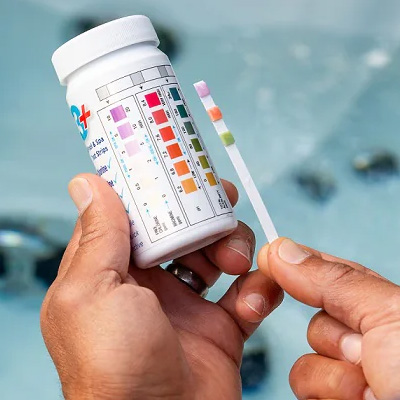
Difficulty Maintaining pH
Difficulty Maintaining pH
- What causes difficulty maintaining pH in the 7.2 – 7.6 range?
First, we need to distinguish between difficulty adjusting your pH to the proper range and difficulty keeping your pH in the proper range.
- 1st Step
If you are having trouble getting your spa water pH into the proper 7.2 – 7.6 range the likely issue is either hard water (a high concentration of calcium) or high Total Alkalinity (or both). Both of these are “pH buffers”. They simply make changing pH more difficult. This can be an advantage when your pH is in the proper range but a problem when you are first trying to get your pH into the 7.2- 7.6 range.
Note: Serum Total Maintenance is also a strong pH buffer. This is great advantage in maintaining the proper pH but it’s critical that you add Total Maintenance AFTER you adjust your pH to within the 7.2 – 7.6 range.
- 2nd Step
If you have hard water, and you have access to soft water in your home, you can fill your spa with 50% outside tap water and 50% inside your home water. This will reduce your calcium level and may also reduce your Total Alkalinity.
- 3rd Step
If you do not have access to soft water, you have two choices. One is simply use a lot more HTS pH Up or HTS pH Down, depending on whether your pH is too high or low.
If your pH is off, its far more likely that its too high out of your tap. If so, you can also use a very small amount of muriatic acid, the same as used in pools to lower pH. However, your spa is much smaller than a pool. When I say a “small amount”, I’m literally speaking of no more than a tablespoon at a time.
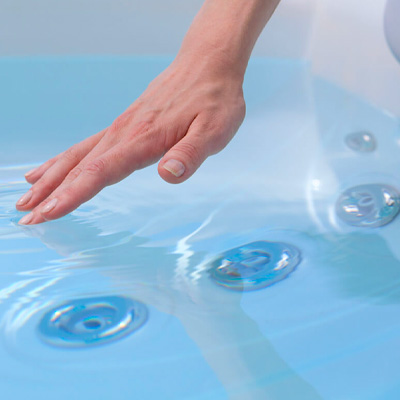
Jets not functioning properly
Jets not functioning properly
- What can cause your hot tub jet to stop rotating?
There are basically four reasons your spa jets might stop rotating and not provide the great massage you want from your hot tub.
- Calcium scaling
You’ve seen my discussion of calcium scaling in several of the previous FAQ’s. When calcium scaling occurs, it appears on every surface under the water. This includes inside your jets where it will jam them up preventing any rotation. Please see our FAQ, “Deposits (Scaling) on your spa shell” to resolve this issue.
By the way, the reason we offer a Lifetime Jet Warranty when you enroll in an Auto-Ship program with your local Serum dealer is because both Serum Total Maintenance and Swim Spa Serum will prevent calcium scaling.
- Broken Jets
Jets in spas from the top manufacturers rarely fail however some do contain ball bearings. Should these pop out, the jet will stop working. The jet insert needs to be replaced.
- Excessively High Sanitizer Levels
Both chlorine and bromine, the most common spa sanitizers, are quite corrosive in concentrations higher than you want in your spa. If you have maintained concentrations in the 10-ppm range or above for many months, both chlorine and bromine can quite literally eat away the plastic in your jets. Not good!
- Age
Spa jets are moving parts. If your spa is quite old, the jet inserts may have simply worn out. If your spa dealer has been in business with the same spa manufacturer for 10 – 20 years or longer, they likely have replacements. They probably won’t match the originals, but they will work giving you the massage you wanted when you bought your spa.
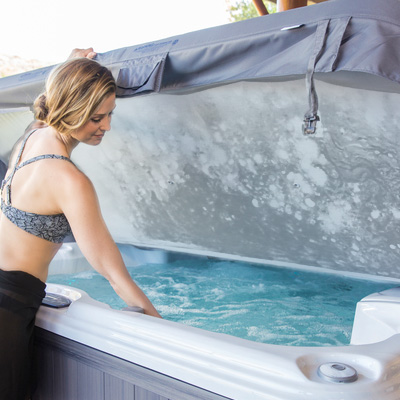
Black Mold on your cover
Black Mold on your cover
- What causes Black Mold under your spa cover and around pillows?
Black mold is a fungus. Fungal spores are often present in the air though this is dependent on weather, time of the year, and your location. Drier areas will tend to have lower levels of fungal spores, while areas with higher humidity will often have higher fungal spore counts.
Like most fungus, black mold loves moist, humid, and dark areas – just what you find under a hot tub cover when closed.
- Preventing Black Mold
Both chlorine and bromine, the most common spa sanitizers, will kill black mold however spa pillows and your cover are not in the water hence, both are areas black mold will favor and can establish themselves.
The most effective way to prevent black mold is to use either our Total Maintenance or Triple Action Spray. Our Total Maintenance is designed to be added to your spa on a weekly basis and has many benefits to help you maintain your spa. It just happens that preventing black mold is one of these benefits.
- Removing Black Mold
Our Triple Action Spray will also prevent black mold when applied to your spa cover every couple of weeks. However, it will also clean black mold from your spa cover so if you already have black mold, Triple Action Spray is the way to go!
1Many folks think of a hot tub as a small pool. It’s really not when it comes to maintaining great water. The reason is this. It’s much harder to maintain great spa water because the sanitation load, or “bather load”, is much higher. Four issues make it more difficult to maintain great spa water.
- A pool often contains 40 – 50x the water volume of a spa. A pool can thus dilute the biologic wastes that occur from use much more than in a spa.
- Spa water is usually 20 degrees warmer than pool water. Most bacteria and other pathogens in a pool or spa like warmer water. They will simply reproduce faster in a spa.
- The massaging jets you love in your hot tub also scrub off millions of dead skin cells, greatly increasing the biologic waste in a spa, and provide a food source for bacteria and other pathogens.
- Most don’t realize that you sweat in a spa because the water temperature is above your skin temperature. You are likely to perspire 1 – 2 pints of sweat in an hour in a spa. This has great therapeutic benefits but is also increases the bather load as your sweat contains urea, ammonia, and other chemicals that need to be removed from your spa water.

